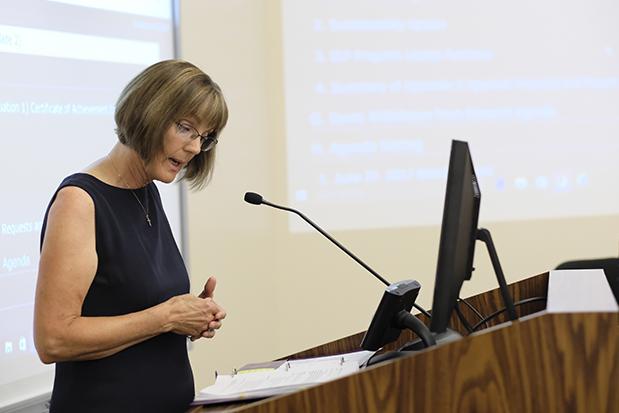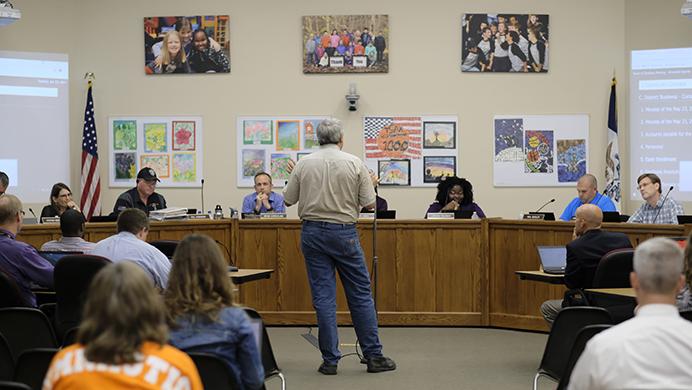A task force advises the Iowa City School District to decrease seclusion room use and to have quarterly meetings to re-evaluate progress.
Seclusion rooms are 6-by-6-foot rooms in classrooms used to isolate students who misbehave. Although these rooms are not outlawed at the federal or state level, a report by the U.S. Department of Education urges districts not to use the rooms. The seclusion rooms are made of plywood and recycled tires. Some of the rooms are extra closets that are converted into seclusion rooms, but some are located in the classroom. Because of the lack of regulations, any child can be put in the boxes regardless of age or disabilities.
By Emily Kresse | [email protected]
The task force championed with adjusting how seclusion rooms are handled in the Iowa City School District has recommended no longer calling them “time-out rooms.” The panel also wants to increase training for crisis intervention — the ultimate goal of reducing the number of rooms and frequency of use. The task force, however, upheld that the rooms were necessary to ensure student and teacher safety.
“No one I know is pro-seclusion and restraint,” said Mary Roberts, a task force member.
Roberts, who has two autistic children who have both required seclusion intervention, is the Autism Center coordinator at the University of Iowa Children’s Hospital; she described the rooms as the “lesser of two evils.”

The 22-person task force met seven times between Feb. 6 and May 22 to go over the physical aspects of these rooms and the practices associated with them. This included, but was not limited to, what behavior constituted using the rooms, how long a student would be put in a room and how often, and the demographics of the students pulled into the rooms.
The task force cited a March report by Hanover Research, which panel members used in their recommendations to the district.
“Seclusion should only be used in circumstances when less restrictive interventions have failed to de-escalate a student’s behavior, or the student’s behavior poses a direct threat to their own health or to the health of other students or staff. Moreover, seclusion should end as soon as the student’s direct threat is over,” the report said.
RELATED: IC District tackles ‘seclusion rooms’
Jane Fry, the School District interim special-education director, said two of the district’s 21 seclusion rooms have been identified as no longer necessary; one will be removed and the other repurposed by the upcoming school year.
Casey Leonard, an art teacher at Mid-Prairie School District and an Iowa City resident, said her main concern with these spaces is that they are used as punitive measure, and she was disappointed the district was not completely eliminating seclusion rooms.
“I’m concerned about loss of learning time [for students in seclusion rooms] and the impact on student-teacher relationship,” she said.

Julie Van Dyke has a special needs son enrolled at Northwest Junior High School, and during his time at Horn Elementary, he had been put in seclusion rooms.
She does not support seclusion rooms because, she said, they create shame and cause the behaviors that are used to justify putting those kids back in those rooms.
Van Dyke also said she was glad to see some School Board members ask questions of the task force members present at Tuesday’s meeting whereas others, she said, were basically nodding heads.
Sean Casey, a challenging-behaviors specialist from the state Department of Education and a member of the task force, said there is a continuum of interventions and the use of seclusion rooms are sometimes the only safe alternative when a child is out of control.
Roberts and Casey both expressed their willingness to be part of the quarterly meetings, which the task force recommended to The Daily Iowan. The task force members also said they are happy with the results of their recommendations, which they attributed to the diverse backgrounds and interests of the members of the force.
LaTasha DeLoach, the School Board’s vice president, suggested that the board implement a comprehensive policy for the district in order to regulate the management of seclusion rooms. The board, she said, should look to other districts and see what kinds of policies are in place and whether or not they could be implemented in the School District.
The board will revisit seclusion rooms in an August work session.
Board member Chris Liebig said that while he understands the rationale behind seclusion rooms, and while he sympathizes with the dangers presented by out-of-control children, the rooms, he said, are little dungeons in the classrooms.







